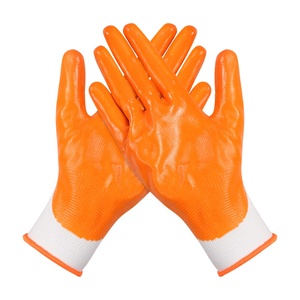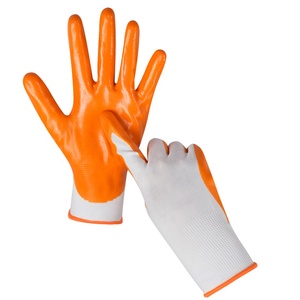(3500 products available)
















































































































































































































Suppliers offer custom nitrile examination gloves in bulk for branding and advertising. Nitrile gloves printed with a logo provide safety and a polished branded look. These gloves come in diverse materials, colors, and thicknesses. Below are the common types available in bulk.
Nitrile is a synthetic rubber made from acrylonitrile and butadiene. Nitrile gloves provide much chemical resistance and are a good option for people with latex allergies. Nitrile is robust and ensures a good grip. They are also puncture-resistant, adding safety. Branded nitrile gloves are ideal for health, automotive, and food sectors.
Vinyl gloves are made from polyvinyl chloride (PVC). They are the most affordable option. While vinyl does not have the same chemical resistance or elasticity as nitrile, it still works well for short-term use. Nitrile gloves are available in diverse colors, like blue, clear, and pink, known for their branding potential. However, vinyl has less durability and is intended for low-risk activities.
Latex gloves are made from natural rubber latex. They offer great elasticity, fit, and feel. They also have great resistance to water and various chemicals. However, some people have latex allergies. Latex gloves are suitable for most industries, like healthcare. Many branded latex gloves are available in diverse colors for an appealing aesthetic.
Neoprene gloves are made from chloroprene, a synthetic rubber. They offer a good balance of strength and flexibility. Greatly resistant to oil, grease, and certain chemicals, neoprene has a higher barrier than vinyl but lower than nitrile. Spandex is often added to increase elasticity. Neoprene is suitable for diverse industries.
Environmentally friendly gloves are becoming popular, with bamboo and plant fiber as the common options. Bamboo has natural antibacterial properties, making it suitable for the healthcare industry. The renewable material also provides comfort and cushioning. In addition, several plant-based fibers offer sustainability without compromising performance. Bth types of gloves are ideal for environmental branding.
Custom gloves are branded and designed to match diverse company ratings and marketing intentions. They assist companies in establishing a unique identity while ensuring that employees and clients are protected. Below are the possible designs for custom logo-printed gloves.
Design patterns are printed on gloves to enhance their appearance and functionality. Various options are available, including floral, geometric, abstract, and brand-related motifs. The patterns are printed using durable inks to ensure visibility and consistency. Using patterns adds a creative element and reinforces brand identity. Custom design patterns can be supplied to have a unique look.
Shape designs include various motifs on gloves, ranging from a simple logo to intricate shapes. Popular shapes include animals, plants, or objects that reflect the company or event’s theme. Such designs are made from strong, flexible materials that keep them intact during use. Shape designs are effective for exhibitions or promoting a company. The design reinforces the brand while providing function.
Nitrile gloves printed with a logo have brand logos directly on them. The logos range from small and discrete to larger, more eye-catching designs. Logos are printed on the gloves during manufacture using durable inks that ensure visibility and vibrancy. The printing technique ensures that the logo does not affect the glove’s functionality or comfort. Logo design helps companies create a cohesive look across different branding touchpoints.
Sleeve design on logo design gloves can be used to advertise and promote certain brands. The sleeves are printed using vibrant colors and intricate patterns, making the gloves appealing. Sleeve materials are strong and elastic to avoid tears while maintaining the design’s visual integrity. Sleeve designs make a vast difference, especially in fashion design and medical industries where presentation matters.
The right gloves depend on variables such as industry needs, nature of working tasks, and individual preferences. Understanding the specifications and maintaining those factors is crucial. Below are various features and maintenance ideas for custom logo-printed gloves.
Nitrile gloves come in various sizes, ranging from extra small to extra large. It ensures a proper fit for several hands. Nitrile has high elasticity and is strong, thus making it an excellent material for different tasks. The thickness varies depending on the industry. For example, medical-grade gloves tend to be thinner for better sensitivity. In contrast, industrial gloves are often heavier for increased protection. Branded latex gloves should be stocked in diverse sizes – small to extra-large. SYtock in tensile strength and elastomers that provide great flexibility and comfort. Also, available are textured fingertips for enhanced grip and precision. Additionally, gloves should be sterile or non-sterile, depending on the application. Manufacturers meet medical-grade requirements for purity and quality on sterile gloves.
As with any gloves, careful inspection is needed regularly when wearing logo-printed gloves. Common areas may include seams, cuffs, and fingertips. Look for small holes, tears, or visible wear, compromising safety. Do not forget to check that the logo or design printed does not obstruct any area responsible for protection. Performing a visual check before use is necessary.
Store branded gloves in a dry, cool area away from sunlight. Extreme temperatures affect the material properties of gloves, leading to a risk of deterioration or decreased safety. Keep them in the original packaging to maintain sterility. Exposure to heat will affect gloves by causing brittleness and possibly tearing during use. Organize gloves according to sizes so they are easy to access during usage.
Nitrile gloves come with varying maintenance requirements. While disposable types are thrown away after use, some can be washed. Washing can be done with mild soap and water and should be done with gloves not exposed to hazardous materials. Disposable gloves should be thrown away when they feel compromised – punctured, torn, or showing visible wear. Clean gloves must be air dried completely before storage to maintain integrity. Do not wash gloves with harsh chemicals or abrasive materials that cause prints to smudge and wear out so quickly.
Material compatibility is graded by industry standards and the uses of branded gloves. Nitrile is puncture-resistant and oiled for heavy tasks. Nitrile has an excellent chemical barrier and is ideal for those with latex allergies. Vinyl is affordable for short-term use. Consider the environment where gloves will be used. For example, latex gloves work well in the healthcare industry due to their elasticity and comfort.
Thickness affects in strength in terms of flexibility and protection. Thicker gloves give protection but reduce sensitivity for delicate tasks. Super thin gloves enable tactile feel but accommodate less safety. Choose the right level of comfort that is bearable by end users. Comfort contributes significantly to factors that determine performance. Select gloves in thickness levels that accommodate comfort and safety for end-users.
Sizing is essential to ensure a proper fit. Sizing determines performance and safety. Choose gloves of various sizes. They should fit snuggly without excess material. Excess material jeopardizes dexterity, while tight gloves cause discomfort and leave marks on the skin. Use a size chart as a reference. Standard industry statistics provide average and common measurements. Test samples to determine comfort levels practically.
Design is part of branding strategy. Consider how design elements incorporate with brand identity. Decide on colors, patterns, and logo placement and how they enhance visibility and impact. Will the design create memorable interactions? Glove designs that are innovative and creative attract attention to a brand. Unify all branding across various materials for consistency.
Ensure all branded gloves meet necessary regulatory agency standards. Certifications are mark of quality and safety in the products. Essential certifications may include medical examination usage or food handling standards. These indicators represent industry standard compliance. Check for eco-friendly certifications to meet green initiatives. Certifications are vital in choosing ethical and responsible products.
Gloves printed with a logo promote a brand by giving safety to the hands at the same time. They work well for marketing while protecting people. Companies use them to boost their name and keep workers and clients safe. They make a business look better and provide good use.
Yes, printed gloves are strong and endure tough work. Nitrile is good for oil, chemicals, and other harsh things. The print stays on well, even in rough heat or work conditions. With little care, they last a long time and keep up their good look.
For a specific business, pick gloves for the job at hand. For medical tasks, choose flexible nitrile because it resists puncturing and chemicals. Industrial use needs thicker gloves to handle heavy work safely. Food service calls for puncture-resistant and chemical-safe gloves.
Their life varies by use, but most last from four to eight hours with care. Busy hands need more frequent changes than light tasks. They protect better the sooner they are swapped out when showing signs of wear.
Indeed, there are eco-friendly choices. Certain hypoallergenic options take into account sustainability. Many are hyped to provide similar glove performance. While not as commonly available, they present greener choices for promotional needs.